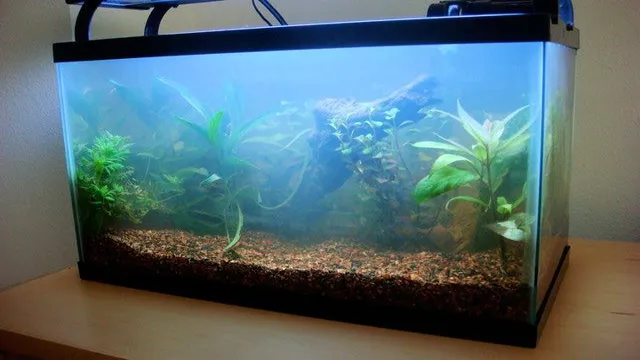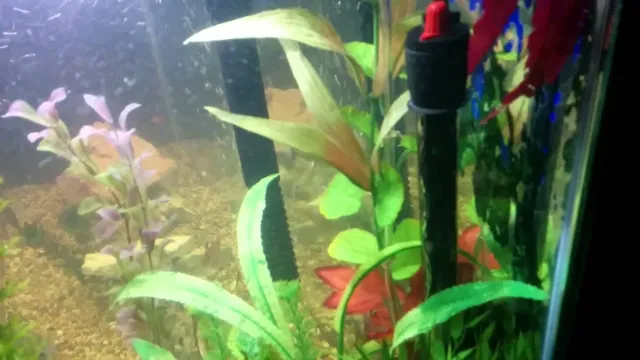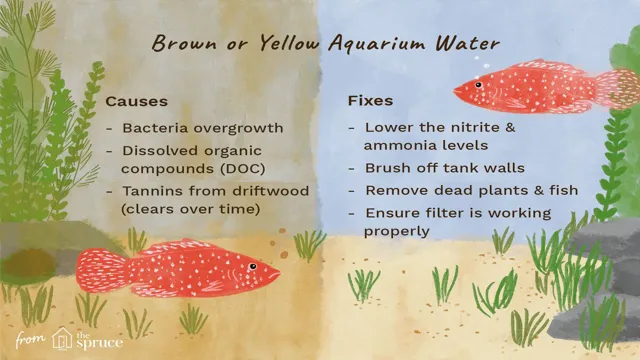Do you want to ensure that your aquarium stays clean and healthy? Look no further than a foam filter! These types of filters are great for aquariums because they absorb debris and waste, keeping your water clear and free of harmful particles. They are also easy to maintain and can be customized to fit your specific tank needs. In this article, we will cover the steps necessary to create your own foam filter for your aquarium.
With just a few materials and some simple steps, you can have a filter that will keep your aquatic friends happy and healthy. So let’s dive in and get started!
Gather Materials
If you’re looking to make a foam filter for your aquarium, the first step is to gather materials. You’ll need a few basic supplies, including a piece of foam to use as the filter material, a container to hold the foam and attach it to your aquarium, and some scissors or a knife to cut the foam to size. You may also want to have some small zip ties or wire to secure the foam in place and prevent it from shifting around in the container.
When selecting your foam, it’s important to choose a high-quality, open-cell foam that will allow water to flow through easily while still trapping bacteria and other particles. Some options to consider include polyurethane foam or bio-filter foam, both of which are readily available online or at pet supply stores. With your materials in hand, you’re ready to start creating your foam filter and enjoying a cleaner, healthier aquarium for your fish.
Foam Sheets, Scissors, Measuring Tape, Ruler, Marker
When it comes to crafting with foam sheets, there are a few essential materials that you’ll need to gather before getting started. First up, you’ll need foam sheets in the colors and sizes of your choice. These can often be found at your local craft store or online.
Next, you’ll need a pair of scissors for cutting the foam sheets into the shapes you desire. It’s also a good idea to have a measuring tape, ruler, and marker on hand for more precise cuts and measurements. These tools will come in handy when measuring and cutting foam sheets to create specific shapes or sizes.
Whether you’re making decorations for a party or creating a new art piece, having these materials on hand will make your crafting process smoother and more enjoyable. So why wait? Get your foam sheets, scissors, measuring tape, ruler, and marker ready, and let’s get creative!

Measure and Cut Foam
If you’re looking to make a foam filter for your aquarium, the first step is to measure and cut your foam to the appropriate size. You’ll want to choose a foam with a density that is high enough to effectively filter your aquarium water, without restricting water flow too much. Once you’ve chosen the right foam, measure it to the appropriate size for your filter housing.
It’s important to be as precise as possible to ensure the foam fits snugly in the housing without any gaps. Once you’ve measured and marked your foam, you can use a sharp blade to carefully cut it to size. Be sure to double-check your measurements before cutting to avoid any mistakes.
With the foam cut to the right size, you can then place it in the filter housing and start enjoying cleaner, clearer water in your aquarium.
Measure the foam sheet to fit the filter’s housing
When it comes to maintaining your filter’s efficiency, fitting a foam sheet to the housing is crucial. To do this, you’ll need to measure the housing and cut the foam sheet accordingly. This ensures that the filter’s interior is completely sealed off, preventing any unfiltered air from entering.
You can begin by measuring the length and width of the filter’s housing, along with its depth. Once you have these measurements, use them to cut the foam sheet to size. This may require some trimming and adjustment, but it’s important to get it just right.
Cutting the foam sheet too big or too small may result in air leakage and decreased filter effectiveness. So take your time and get it done correctly. Remember, a properly fitting foam sheet is a small but essential component of your filter’s health and performance.
Cut foam to snugly fit the housing
Foam When it comes to protecting electronic devices during travel or storage, foam is an excellent material to use. It is easy to cut and can snugly fit the housing, ensuring no movement or damage during transport. The first step is to measure the dimensions of the housing and then use those measurements to cut the foam.
It is best to work in small increments, cutting a little at a time until the foam fits snugly around the device. Be sure to leave enough space for any cords or accessories that may be included with the device. It is important to remember that the foam should not be too tight as it can put pressure on the device, causing damage. (See Also: How to Get from Kyoto to Osaka Aquarium: Your Step-by-Step Guide!)
On the other hand, if the foam is too loose, the device can move around inside the housing, leading to potential scratches and damage. With some patience and attention to detail, cutting foam is a great way to protect your electronic devices.
Create Slits for Water Flow
If you’re looking to create a foam filter for your aquarium, one important step is to create slits for water flow. This helps ensure proper water flow through the filter and prevents any buildup or blockages. To create the slits, you can use a utility knife or razor blade to carefully cut small, evenly spaced slits along the sides of the foam.
It’s important to be precise and consistent with the size and spacing of the slits to ensure proper water flow. Once the slits are created, you can place the foam into the filter and secure it in place. With this simple step, you’ll have a high-functioning and effective foam filter for your aquarium.
Measure horizontally and mark with a ruler and marker
When it comes to creating slits for water flow in a surface, a ruler and marker can be your best friends. Measure horizontally to ensure uniformity and mark the spots where you want to cut. It’s crucial to pay attention to every detail and make sure the marks align.
Whether you’re building a DIY drainage system or a decorative feature in your garden, creating slits properly is essential for water flow and plant health. The width and depth of the slits largely depend on the material you are using and the desired water flow rate. Be sure to use a sharp blade or cutting tool, and take your time to prevent unwanted slips and jagged edges.
Trust me, it’s worth the effort to do it right the first time. By following these steps, you’ll be on your way to creating an efficient and visually pleasing water drainage grid.
Cut slits to fit horizontally across the foam sheet
To create efficient water flow in your hydroponic system, it’s essential to cut slits horizontally across the foam sheet. These slits allow water to flow freely through the system and reach the roots of your plants. You can use a sharp knife or scissors to make these cuts in your foam sheet.
It’s recommended to make the slits around one inch apart so that each plant has space to receive water. By creating slits in your foam sheet, you can ensure proper water distribution and avoid any risk of mold or bacteria buildup. With a bit of careful cutting, your hydroponic system will be set up for success, providing your plants with the ideal environment to thrive and grow.
Assemble the Filter
Making a foam filter for your aquarium can be an effective and inexpensive way to keep the water clean and clear. To assemble the filter, you will need a foam block or sheet, scissors, and a plastic container or hang-on-back filter. Cut the foam to fit inside the container or filter, making sure there are no gaps around the edges.
You can also cut out a section in the middle of the foam for added surface area and water flow. Next, rinse the foam with clean water to remove any debris or dust. Finally, insert the foam into the container or filter and attach it to the aquarium.
The foam will trap and filter out any floating debris, fish waste, and uneaten food, providing a healthier and more enjoyable environment for your aquatic pets. With just a few simple steps, you can easily create a custom foam filter for your aquarium that will help keep your fish happy and healthy for years to come.
Insert the foam filter into the housing
After cleaning the foam filter, it’s time to reassemble it. The first step is to insert it back into the housing. This might sound easy, but there are a couple of things to keep in mind.
First, make sure the filter is oriented correctly. Usually, there is a top and a bottom, and you want to make sure the airflow arrows are pointing in the right direction. This will ensure that the filter is doing its job properly.
Secondly, don’t force the filter into the housing. It should fit snugly, but not so tight that it’s difficult to remove next time. If it’s difficult to insert, double-check that you have the right orientation. (See Also: How to Lower the pH in a Planted Aquarium: Tips and Tricks to Create a Healthier Environment for Your Fish)
With a little bit of patience, you should be able to get the filter back in place without any issues. Keep in mind that the foam filter plays a crucial role in keeping your equipment running smoothly. It helps prevent dust and debris from entering the engine, which can cause damage and reduce performance.
So, taking care of your foam filter is essential to ensure your equipment lasts as long as possible. With regular cleaning and reassembly, you can keep your air filter in top shape and avoid costly repairs.
Attach the filter to the aquarium pump
After you have assembled your aquarium filter properly, it’s time to attach it to the aquarium pump. The first step is to take the pump and locate the intake and outlet ports. You will see a small rubber adapter on the intake port – slide it off carefully.
Then, take the filter and align the intake tube with the pump’s intake port. Push the intake tube securely onto the port, and then slide the rubber adapter back onto the tube. This will hold the tube firmly in place and stop any water from seeping out.
Once the intake tube is attached, take the outlet tube from the filter and connect it to the pump’s outlet port. Make sure it’s a tight fit, so there’s no leakage. Now that your filter is successfully attached to the pump, plug your pump in to operate it.
The pump will now pull water through the intake tube, into the filter media, and back out through the outlet tube. This cycle will ensure that any debris and contaminants are removed from your aquarium water, resulting in clear and healthy water for your fish. Remember to clean and maintain your filter periodically to ensure it continues to function optimally.
With a well-maintained filter and pump system, you can enjoy the beauty of your aquarium with minimal effort and maximum results.
Maintenance
If you are looking for a simple and affordable way to maintain the cleanliness of your aquarium, then making a foam filter is the way to go. Foam filters are effective at removing debris and waste from the water, ensuring that your aquarium stays clean and healthy for your aquatic pets. To make a foam filter for your aquarium, you will need a piece of foam filter material that fits your aquarium size and a plastic tubing for the water outlet.
Begin by cutting the foam filter to fit the size of your aquarium. Make sure to leave enough space for the plastic tubing to fit securely onto the water outlet. Next, attach the plastic tubing to the foam filter, making sure that it fits snugly.
Finally, insert the filter into your aquarium and let it do its job. Be sure to clean the foam filter regularly to maintain its effectiveness. Making a foam filter for your aquarium is an easy and inexpensive way to promote a healthy environment for your aquatic pets and maintain the overall cleanliness of your aquarium.
Regularly replace the foam filter to prevent clogging
Regularly replacing the foam filter in your cleaning equipment is vital to ensuring optimal performance and preventing clogging. As dust and debris accumulate on the filter, the suction power of your vacuum or air purifier begins to diminish, making it less effective in removing harmful particles from your environment. The frequency of replacement will depend on the level of usage and the amount of dirt and debris in the air.
However, it’s recommended to replace the foam filter every three months to avoid any decrease in performance. By regularly replacing the foam filter, you can ensure that your cleaning equipment is functioning at its best and improving the air quality in your home or office. So, don’t wait until your equipment starts to show signs of reduced performance; remember to replace the foam filter regularly and stay on top of your cleaning game!
Rinse the filter in aquarium water when dirty
When it comes to maintaining a healthy and clean aquarium, one of the most important things you can do is to regularly clean the filter. Over time, the filter can become clogged with debris and waste, which can affect the water quality and harm your fish. That’s where rinsing the filter in aquarium water comes in.
This simple task should be done regularly to ensure that the filter is functioning properly and keeping your water clean. To rinse the filter, start by unplugging the filter from the power source. Carefully remove the filter media from the filter housing and rinse it under a steady stream of water. (See Also: How to Make a Charcoal Filter for Aquarium: Step-by-Step Guide)
However, using tap water can also cause issues, so it’s better to use aquarium water (that should be used after a water change) instead. Make sure you don’t scrub or use any soap to clean the filter as this can harm both the filter media and your aquatic creatures. Overall, cleaning your aquarium filter is an essential maintenance task that should not be neglected.
By rinsing the filter in aquarium water when it becomes dirty, you are ensuring that your aquarium’s environment remains healthy and safe for your fish. Regular maintenance will not only help in keeping your aquarium clean but also extend the life of your equipment. So, make sure to take care of your filter and give your fish a healthy and happy home.
Conclusion
In conclusion, making a foam filter for your aquarium is not rocket science, but it does require a certain level of patience and attention to detail. Like any DIY project, there are always different ways to approach the task, but ultimately the key is to ensure that the filter is properly sized for your tank, the foam is high quality and well-fitted, and the water flow is optimal. So, whether you’re a seasoned aquarium hobbyist or a novice just getting started, remember that a little creativity and a few foam filter-making skills can go a long way in ensuring a healthy and happy underwater ecosystem.
Now go forth and foam it up, my finned friends!”
FAQs
What materials do I need to make a foam filter for my aquarium?
To make a foam filter for your aquarium, you will need a piece of foam sponge, filter floss, scissors, zip ties, and a plastic container with a lid.
Can I reuse a foam filter for my aquarium?
Yes, you can. After the foam filter becomes clogged with debris, rinse it with tap water and reuse it.
How often should I clean my foam filter?
You should clean your foam filter once a week to ensure that it’s removing debris and creating a healthy tank environment.
Is using a foam filter better than using a traditional hang-on-back filter?
Using a foam filter is beneficial because it is inexpensive and doesn’t require electricity. It also provides a larger surface area for beneficial bacteria growth, which helps maintain water quality.
Should I put a foam filter in my quarantine tank?
Yes, you should. A foam filter is a great addition to a quarantine tank because it will help remove debris and harmful bacteria from the water, keeping your fish healthy.
How can I make my foam filter work more efficiently?
You can make your foam filter work more efficiently by adding filter floss to the top of the foam. The filter floss will help trap smaller debris, leading to cleaner water.
Can I customize the shape and size of my foam filter?
Yes, you can. The beauty of foam filters is that they are easy to customize to fit any aquarium or tank shape and size. Simply cut the foam sponge to the desired shape and add zip ties to secure it in place.







